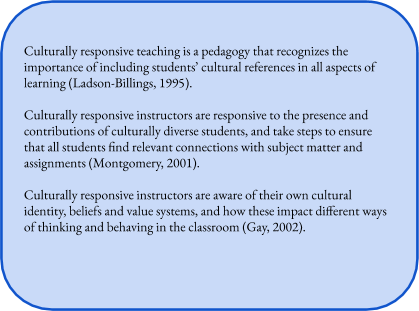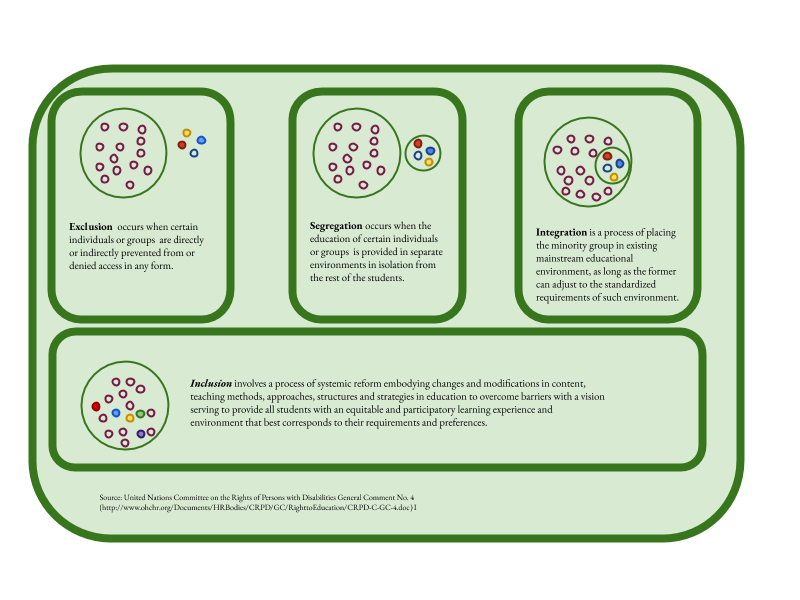|
|
Earn Inclusive, Intercultural, Global Pedagogy Certification |
The idea of inclusive teaching emerged from the civil rights movement as a way to foster respect, and equity for various groups of people (Banks 2001:77, cited in Warren 2005 and Hockings 2010). Fundamentally, inclusive teaching is about intentionally and deliberately ensuring that all students’, regardless of their backgrounds, are taken into consideration when designing courses, crafting a syllabus, developing learning activities, preparing assignments, and working on creating a supportive, student-centred learning environment.
Gannon (2018) described inclusive teaching as “a mindset, a teaching-and-learning worldview, more than a discrete set of techniques. But that mindset does value specific practices which, research suggests, are effective for a mix of students.”
This overarching view of inclusive teaching is particularly important as it encapsulates a wide range of individual as well as group differences within the student population. These differences may then include, but are not limited to, gender, race, age, class, socioeconomic status, physical or mental ability, gender or sexual identity, religion, or ethnicity. This can allow us to broadly distinguish between inclusive teaching and culturally responsive teaching.
 The difference is that while culturally responsive teaching focuses on specific and
existing cultural differences, inclusive teaching approach focuses on creating and
implementing a teaching and learning environment that takes into consideration all
forms of individual and group differences, including culture, race and ethnicity,
age, ability, gender, sexuality, socioeconomic background, and other individual and
social differences that impact people’s learning experiences.
The difference is that while culturally responsive teaching focuses on specific and
existing cultural differences, inclusive teaching approach focuses on creating and
implementing a teaching and learning environment that takes into consideration all
forms of individual and group differences, including culture, race and ethnicity,
age, ability, gender, sexuality, socioeconomic background, and other individual and
social differences that impact people’s learning experiences.
In the extant literature several terms are used when discussing the concept of inclusion. The picture below illustrates the distinction between inclusion and the concepts of exclusion, segregation, and integration.

The “Overview of Inclusive Teaching” is a self-paced, online course intended to assist faculty members to develop and enhance their teaching skills and establish a foundation for a lifetime of inclusive teaching. The purpose of this workshop is to provide faculty members with a brief overview of the concept of inclusive teaching and the idea of Universal Design. It also aims to give participants the opportunity to identify and to develop a plan to implement inclusive practices in their teaching, and to reflect on their own mindset and readiness for being agents and practitioners of equity-based, inclusive pedagogy. This course also aims to provide instructors with tools that are immediately applicable to their teaching contexts.
At UVU, inclusion refers to a commitment “to preparing all students and employees for success in an increasingly complex, diverse, and globalized society. We promote civility and respect for the dignity and potential of each individual. We seek to advance the understanding of diverse perspectives. We value and promote collegial relationships and mutual respect among students, faculty, and staff. We acknowledge and seek
to address the needs of populations who are underrepresented and students with varying levels of academic preparation, even as we strive to provide access and support for all students and employees in ways that are culturally relevant and responsible.”
Hockings, C. (2010) Inclusive learning and teaching in higher education: a synthesis of research. York: The Higher Education Academy. Available from: www.heacademy. ac.uk/assets/York/documents/ourwork/ inclusion/wp/inclusive_teaching_and_ learning_in_he.doc [20 December 2010].